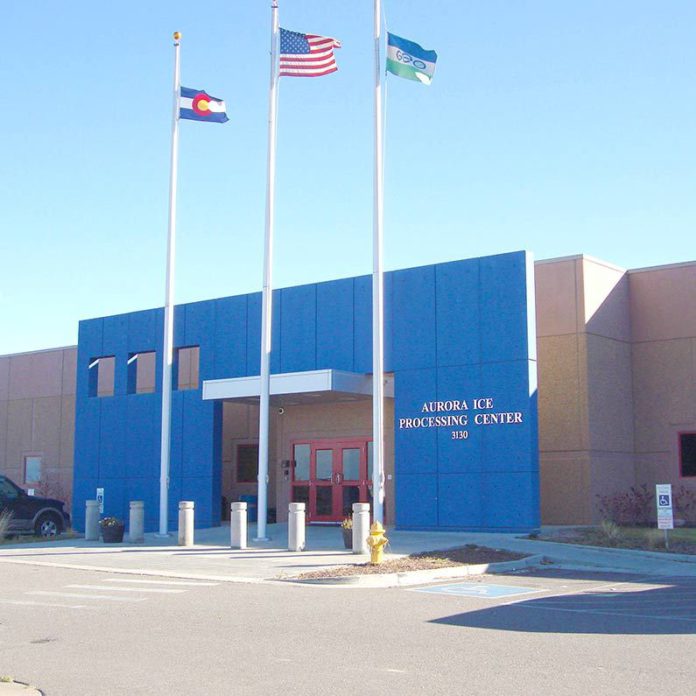
U.S. Immigration and Customs Enforcement confirmed last week that two people in its custody at the Aurora immigrant detention center have tested positive for COVID-19, the first two cases of coronavirus among detainees at the facility.
The positive cases at the Aurora facility are just two of the over 1,200 cases confirmed by ICE among detainees nationwide.
In the May 20 ICE Aurora Contract Detention Center Accountability Report, two detainees had tested positive, and two ICE personnel in the facility were “confirmed COVID-19 tested positive.” There were also five GEO staff members at the facility confirmed positive for COVID-19.
An ICE employee who tested positive for the virus last worked at the facility on May 17, according to the report, which is available from Rep. Jason Crow’s website.
The report mentions that Crow’s office inquired about whether the second detainee had interaction with other detainees, however, “ICE staff did not provide responses to this question at the time of the posting of this report.”
Any detainee who displays symptoms is isolated and tested “if medical determines there is a need,” according to the report. Those in isolation “should have” access to counsel via telephone or tablet, “like any other detainee in the facility.”
Conditions within the facility have been “all over the place” during COVID, said Ana Rodríguez, Community Organizer with Colorado People’s Alliance. She said oneinconsistency is in detainees’ access to masks. At first, the detainees did not receive masks, but around a month ago, they were being given masks, she said. Most receive the masks on Monday, Wednesday and Friday, and are allowed to keep them until the next mask delivery. These masks are surgical masks, which rip easily, and are not designed for multiple use, she added.
In mid-March, COPA began pushing for the release of detainees who were at risk of contracting COVID-19, and a letter was sent to the ICE field director on March 19 to release detainees at the facility, she said. Approximately 1,000 people signed the letter, including several state elected officials and Aurora and Denver city council members.
“The results of that effort, we were one of the first centers to see releases through humanitarian parole,” Rodríguez said, which COPA attributes to the pressure from the community.
Rodríguez cited several other concerns within the facility that have either been addressed after COPA or community members voiced their concerns. She said in one of the pods, detainees were not receiving clean towels, cleaning supplies or paper towels for days at a time. That was an issue COPA flagged to congressmen and was resolved, Rodríguez said. In spite of calls for social distancing, the facility was not spreading the detained out across the facility, Rodríguez said.
COPA also began pushing for ICE to use “every” unit in the Aurora facility, Rodríguez said. The facility has a capacity of approximately 1,500 people, but Rodríguez believed there were approximately only 600 people actually in the facility, and in many cases, only certain cells were being used and at full capacity. In those weeks, pressure began for spreading people across the facility and ICE did cut the capacity of cells in half, Rodríguez said.
“But it seems that since the states reopened, they started getting more relaxed on the procedures once again,” Rodríguez said. Over the past weeks, as the state began to reopen, COPA started receiving calls from detainees telling them that new detainees were being admitted to the facility, and cells returned to their maximum capacity, she added.
Crow’s office asked a series of follow-up questions, which covered topics such as the number of detainees per cell in the main building, changes in practices subsequent to the “shift” to safer-at-home guidelines, if other detainees would be tested due to the positive cases, the cancellation/postponement of court hearings due to video equipment challenges and phones in living quarters not working properly.
“ICE staff did not provide responses to any of the follow up questions at the time of posting of this report,” the report states.
On March 22, a couple dozen individuals, practicing social distancing, rallied on the sidewalk at the Aurora facility. Others were in their vehicles acting as a caravan, honking and making noise around the facility. This effort was made by human rights groups and families of detainees to demand the release of detainees after the two confirmed cases, according to a COPA press release.
Currently, COPA is supporting the work of community organizations working with impacted families, Rodríguez said. Since May 23, some people have been camping outside of the facility in Aurora — and plan to stay on the premises until detainees are released — and nightly vigils are being hosted at 8 p.m. COPA plans to support these efforts, she said.
COPA is also working on a piece of state legislation that would bring immigrant detention centers, including GEO and minor immigration detention centers, under state jurisdiction for inspection purposes, Rodríguez said. This item was not introduced before the adjournment of the state legislature due to COVID-19, but with sponsors including Majority Leader Alec Garnett, Rodríguez is hopeful it will be introduced in the next few days.
ICE did not respond to requests for comment by the time of publishing this article.
—Avery Martinez

